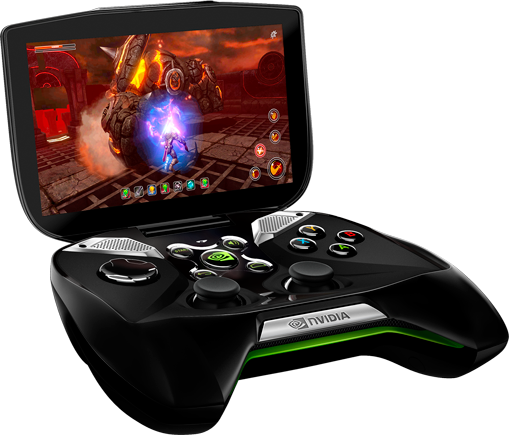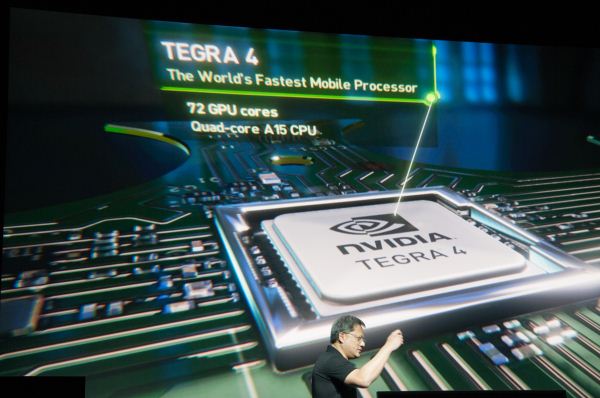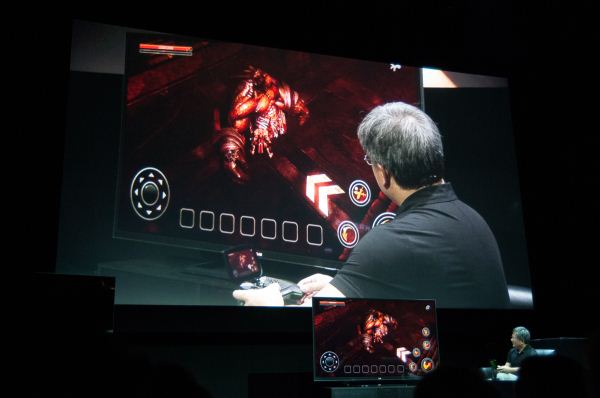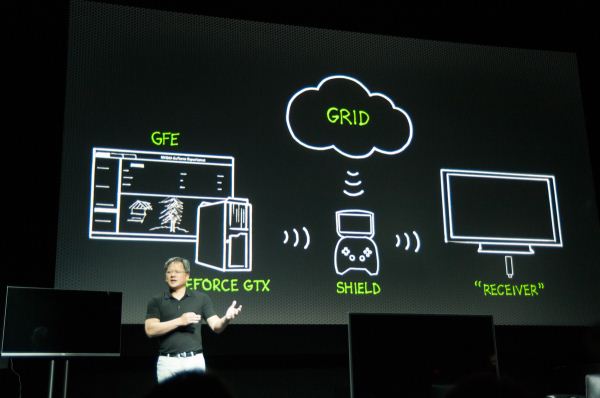NVIDIA Rolls Their Own Handheld Console: Project Shield, Powered By Tegra 4
by Ryan Smith on January 7, 2013 1:14 AM ESTNVIDIA Rolls Their Own Handheld Console: Project Shield, Powered By Tegra 4
Though most of the important launch details of Tegra 4 were leaked weeks in advance, NVIDIA did manage to keep their final major CES announcement under wraps to the very end. Wrapping up their CES presentation, NVIDIA has announced that they will be entering into the handheld console business with their own Tegra 4 powered console, dubbed Project Shield.

While we’re still waiting on NVIDIA for further details, what we do know so far is that Project Shield is essentially a handheld console built around NVIDIA’s recently announced Tegra 4 SoC. Details on Tegra 4 are still sparse since NVIDIA has not announced the individual SKUs, but we do know that the top-end configuration contains 5 ARM A15 CPU cores in a 4+1 configuration similar to Tegra 3, and on the GPU side is backed with a hereto unknown GPU architecture composed of 72 GPU cores.
All of this is built into an oversized game controller that is configured very similarly to the PS3 DualShock 3 controller, possessing 2 concave thumbsticks, a 360-like D-pad , 4 face buttons, and 4 shoulder triggers/buttons (2 on each side). Topping off the console is a 5” 720p multitouch display (no word yet on whether it’s OLED or LCD) that flips over the console in a clamshell fashion. Meanwhile powering the device will be 38 watt-hours of Lithium-Ion battery cells; this is roughly between the Nexus 10 (33.75Wh) and the iPad 3/4 (42.5Wh), meaning Shield will have what amounts to a tablet-capacity battery.
Backing that hardware, storage is provided by a combination of internal and external storage; external storage is provided by a micro-SD card slot found on the back side of the handheld. Also found on the back side of the handheld are a number of other ports: micro-HDMI for display output (4K resolution supported!), micro-USB for data connectivity, and a standard 3.5mm audio jack for headphones. Wireless connectivity is also available, with WiFi for data and Miracast plus additional formats for video output.
On the software side of things Project Shield is running what NVIDIA is calling “pure Android”, which in this case is presumably a reference to them not doing any skinning/customizations, ala MotoBlur, TouchWiz, and other OEM customizations. This means that Project Shield is capable of running standard applications (something NVIDIA made sure to demo) and is otherwise usable as a standard Android device. Meanwhile NVIDIA’s Shield application is where gaming takes place, effectively launching users into NVIDIA’s own sandbox, where gamers can pick up Shield-optimized games from the TegraZone store and then run them on the device.
Finally, on the software side of things NVIDIA is also going to be offering a level of integration between Project Shield and their GeForce products by offering their own Splashtop-like remote gaming experience. By leveraging the Video Codec Engine video encoder inside their recent GTX 600 video cards, Project Shield devices will be able to connect to PCs to do remote gaming. To show this off NVIDIA showed a GTX 680 equipped PC running Steam in Big Picture mode being streamed to Shield, the logical pairing to Project Shield’s dual nature as a portable computing device and a controller. Shield will of course also be able to function as an endpoint for any cloud game service providers using NVIDIA's GeForce GRID technology.
Edit: At this point NVIDIA has not announced hard pricing or availability, but we have been given guidance that "Shield will launch in Q2 at a price competitive with other mobile gaming systems and tablets." Since the critical component here is Tegra 4, the Q2 projection for Project Shield’s availability most likely hinges on when exactly T4 will become available this year.
| Handheld Specification Comparison | ||||||||
| Project Shield | Sony PS Vita | Nintendo 3DS XL | Google Nexus 7 | Apple iPad mini | ||||
| Display | 5-inch 1280 x 720 | 5-inch 960 x 544 OLED | 4.9-inch 800 x 240 + 4.2-inch 320x240 TN | 7" 1280 x 800 IPS | 7.85-inch 1024 x 768 IPS | |||
| CPU | NVIDIA Tegra 4 (4+1 Cortex A15) |
4 x Cortex A9 |
2 x ARM11 |
1.3 GHz NVIDIA Tegra 3 (T30L - 4 x Cortex A9) | 1GHz Apple A5 (2 x Cortex A9) | |||
| GPU | NVIDIA Tegra 4 (72 GPU cores) | PowerVR SGX543MP4 | PICA 200 | NVIDIA Tegra 3 (T30L) | PowerVR SGX543MP2 | |||
| Connectivity | WiFi, HDMI, USB | WiFi, USB | WiFi | WiFi , USB | WiFi, Lightning | |||
| Memory | N/A | 512MB + 128MB | 128MB + 6MB | 1GB | 512MB | |||
| Storage | N/A + Micro-SD | Proprietary | 2GB + Micro-SD | 16GB | 16GB | |||
| Battery | 38Wh | 8.2Wh | 6.5Wh | 16Wh | 16.3Wh | |||
| Starting Price | N/A | $249 | $199 | $199 | $329 | |||
Source: NVIDIA Project Shield Page



















26 Comments
View All Comments
Ryan Smith - Monday, January 7, 2013 - link
This wasn't suitable to put in the article itself, but for all the importance NVIDIA lavishes on the controller I'm rather dour on it.The controller is effectively a PS3 DualShock 3 cross-bred with the Xbox 360 controller. The end result is the thumbstick placement of the DualShock 3 combined with a D-Pad that looks incredibly similar to the XBox 360's D-Pad, which may very well indicate that it's not a D-Pad at all but rather a very shallow hat switch/stick. The screen means this device is going to be top-heavy, but the thumbstick placement means that your middle fingers are going to be rather low on the device due to the low placement of the thumbs.
Dustin Sklavos - Monday, January 7, 2013 - link
I'm still of the impression that the controller is going to be vastly superior to what handhelds enjoy today, though.I was really impressed by Project SHIELD, but they *need* to hit a competitive price point. Anything over $250 and they're SOL.
Ryan Smith - Monday, January 7, 2013 - link
I suppose it depends on if we're talking about handhelds as in smartphones or in handhelds like the 3DS/PS Vita. The latter is almost identical, save for the fact that it has 1 row of shoulder buttons instead of 2 due to size.In fact the quality of a controller is almost entirely down to size (D-Pads withstanding). Sony had to go bigger just to use their relatively small thumbsticks. You can get a true console controller, but it has to be console controller sized. This is clearly bigger than a 360 gamepad, so you're looking at something between that and the original Xbox "Duke" controller. it gives you plenty of space, but I doubt we're looking at something that has any hope of going into a pocket.
Dustin Sklavos - Monday, January 7, 2013 - link
I don't know, I see this as a Sega Nomad that doesn't suck.silverblue - Monday, January 7, 2013 - link
Wow... talk about a (lukewarm) blast from the past.cjb110 - Monday, January 7, 2013 - link
Was about to post that its a pity that it didn't copy Xbox's stick placement, as it makes more sense for the modern game. But on mobile games, where the control methods are often simpler, it does make sense for the d-pad to be in the more natural position.This might also mean Nvidia start doing there 'The Way It's Meant To Played' scheme to android devs...this would certainly help combat the iOS centric development that currently happens.
Also given the relative failures and shrinking of the PSP/DS market, Project Shield might not be as pointless as it sounds.
Aikouka - Monday, January 7, 2013 - link
I hope that the d-pad isn't like the terrible 360 d-pad!One thing that I'm curious about is why the screen remains enabled when you're outputting to another source. I'm assuming that the screen will be a fairly decent drain on the battery (5 inch IPS probably at 720p), and it doesn't really make much sense to mirror the content. Maybe they could eventually pull a Nintendo and offer differing views like the Wii U?
I still argue that smartphones are the future for mobile gaming. It isn't an argument of better input methods, but rather what you have on you at the time. It doesn't matter if the Shield is better than my phone, I keep my phone on me almost 100% of the time. Frankly, it's more available. The one advantage that this does have is if you already own a Tegra-based device,and you've purchased Tegra-only game variants, those'll work great on this.
CeriseCogburn - Monday, January 14, 2013 - link
Three 18650 li-ons inside. At 2400mah each or better.roltzje - Thursday, January 10, 2013 - link
Have you actually used the machine? To me it seems like they could easily balance the moment from the LCD by positioning the batteries inside the controllers grip area, where there is a ton of space.The thumbsticks dont look any lower than the Dualshock's placement, and most have no complaints about that.
schulmaster - Monday, January 7, 2013 - link
The PSP was temporally viable, the PSPGo its successor was a failure due to a less lucrative placement in time. It is not just the benchmark-esque processing power of a mobile gaming device that garners its success, but its button layout, form factor,and most importantly its software level support, that will be prescient of its success in the market. Terga 4 is vastly adequate for mobile gaming from a technical standpoint, but that is not what yields a viable mobile gaming solution. As excited as I was for the PSP, I was equally disappointed by the the technically superior "go." Nvidia's software development is sufficient at best for its two market active desktop/mobile desktop architectures, and I anticipate this mobile sector will receive subsidiary support to that level of adequacy.